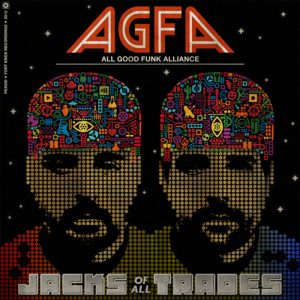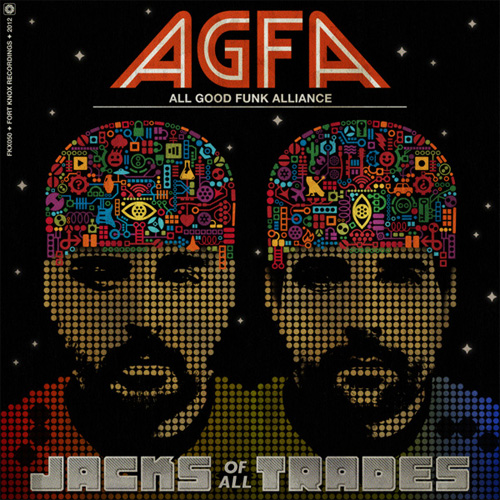 Following up on 2011’s critically acclaimed Rhythm and FX EP, Nu-funk pioneers, the All Good Funk Alliance, release their newest record entitled Jacks of all Trades on Fort Knox Recordings. The duo, comprised of Frank Cueto and Rusty Belieck, has played in clubs around the world, opened up for James Brown, and written songs for Coca-Cola, so its clear that these guys are no strangers in the EDM world. I had the opportunity to check out their newest release, and found that it delivers both funk and a little something extra.
Following up on 2011’s critically acclaimed Rhythm and FX EP, Nu-funk pioneers, the All Good Funk Alliance, release their newest record entitled Jacks of all Trades on Fort Knox Recordings. The duo, comprised of Frank Cueto and Rusty Belieck, has played in clubs around the world, opened up for James Brown, and written songs for Coca-Cola, so its clear that these guys are no strangers in the EDM world. I had the opportunity to check out their newest release, and found that it delivers both funk and a little something extra.
The opening track entitled “Motivate featuring Rubber Johnson” begins with a searing synth intro that evolves into a heavy funk beat. The steadiness of the tune is soon punctured by strangely clipped vocal samples that burst into the stereo field then disappear as quickly as they came. Around a minute and a half, there’s the addition of a thick synth bass melody, filled out by an ambient synth drone that floats in the background, creating a stylistically complex atmosphere. The song reaches its peak with the introduction of vocals around 2 minutes signing, “We are here to start this fire, light it up.” The music suddenly drops off around 3 minutes, leaving the listener hungry for what’s to come next.
I wasn’t sure what to make of the tune initially. While listening, I found myself bobbing my head along with the music, while another part of me was a bit confused as to what these guys are going for. What type of sound are they trying to create? And from what era?
The third track, “Throw Down featuring Neighbour and Think Tank” threw me for an even bigger loop. The track opens with a raucous acoustic percussion section featuring agogo bells and steel drums, then suddenly is drenched in a thick, ugly, dubstep bass line. Just when I thought to have the music figured out, rapper Think Tank takes center stage and lays down a verse, which leads to an aggressive chorus of “pick this up, sorry bout the throw down,” atop a frenzied synth melodic line.
While listening, I took the time to compile a list of genre influences I recognized throughout the song. I came up with: Funk, Disco, Old School Rap, Dubstep, Acid House, and probably many more. Now, I give AGFA credit in attempting to combine all these influences in one track, but on some level, I felt the music was overdone. Combining so many sources of influence requires the listener to process a lot of different information at once, and I’m not sure if the end effect is is something positive or successful.
Thankfully, I feel the album established a middle ground for all of its influences in the fifth track entitled “Time to Get Loose featuring Big Stuff and Think Tank.” The song starts out with what sounds to be a classroom of children saying, “I pledge allegiance to the groove,” and is followed by a simplistic, driving synth beat that’s punctuated by heavy synth chords. Around 45 seconds, rapper Big Stuff breaks into the mix, laying down fast, cocky lines like, “now you can answer the question I ask ya: who’s comin at ya? That’s when I pass ya. I’m a national disaster.” And the verse breaks are similar to dubstep breakdowns, with wall-of sound type bass that envelops the listener in its energy.
I felt this track was successful because of its sparse nature. It utilizes all of the influences I listed above, but in tasteful moderation, not all at once. So it seems that AGFA’s music functions successfully when the energy is kept high, and the genre information is introduced more gradually.
Another intriguing track on the album is the all-instrumental “Speaker Sweat.” This song is much more consistent in structure, relying on a slap-bass and even a sub-bass line to underline the music. Also, this track is far more ambient in texture than most of the other tracks on the album. This is best represented around 2:40 with the dropping out of the drum beat and the foregrounding of a dreamy atmospheric synth line, which presented a kind of delicacy unexplored elsewhere on the album. Finally, I felt like this track successfully gives a sense of repose from the album’s other hard-hitting tracks, as it so much mellower in nature.
The album’s closer, “Closer To The Edge featuring Piper Davis,” is, in my opinion, a relatively unremarkable track. The tempo and structure of the music feels similar to earlier track “Ain’t True,” and while the bass line is clear and crisp over a spacey synth ambience, nothing about the layering struck me as catchy or memorable. One of the elements of the song I found refreshing was the featuring of the female vocalist, Piper Davis, who adds an interesting texture to the music that isn’t found elsewhere on the album. The energy of the piece stays relatively constant throughout, and ends up becoming redundant after about two minutes, after which no new elements are introduced.
I walk away from Jacks of all Trades feeling both intrigued and frustrated. I like that All Good Funk Alliance is so bold in pursuing a type of music that is rooted in so many different influences, but, I venture to say that they don’t necessarily have their song-building basics down in this album enough to pull it off successfully. Which is not to say that there weren’t songs that worked well, and I found those songs to be similar in that they were either very consciously sparse and textural, or very lush and atmospheric. But a lot of the tracks fell…well, somewhere in between. The tracks I felt were unsuccessful simply presented too much information at once, and didn’t really leave any indicators as to how the listener should process it all.
Looking at the album holistically, I felt like it could easily have been half as many tracks. With the discarded tracks, the group probably could release a pretty solid B-sides record, but as of now, reaching the end of the 13 tracks is something of an oasis. On the whole, Jacks of All Trades is really hit or miss, and picking and choosing which tracks/musical elements to keep and which ones to dismiss seems to be this band’s greatest strength, as well as their greatest weakness.




